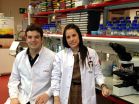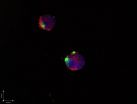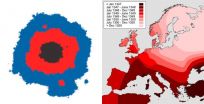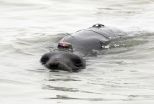(Press-News.org) In a recent paper published in Nature Nanotechnology, Joel Moser and ICFO colleagues of the NanoOptoMechanics research group led by Prof. Adrian Bachtold, together with Marc Dykman (Michigan University), report on an experiment in which a carbon nanotube mechanical resonator exhibits quality factors of up to 5 million, 30 times better than the best quality factors measured in nanotubes to date.
Imagine that the host of a dinner party tries to get his guests' attention by giving a single tap of his oyster spoon on his crystal glass. Now, imagine, to the amazement of all, that the crystal glass vibrates for several long minutes, producing a clear ringing sound. Surely the guests would marvel at this almost never ending crystal tone. Some might even want to investigate the origin of this phenomenon rather than listen to the host's speech.
The secret of such an imaginary non-stop vibrating system relies on the fact that it dissipates very little energy. The energy dissipation of a vibrating system is quantified by the quality factor. In laboratories, by knowing the quality factor, scientists can quantify how long the system can vibrate and how much energy is lost in the process. This allows them to determine how precise the resonator can be at measuring or sensing objects.
Scientists use mechanical resonators to study all sorts of physical phenomena. Nowadays, carbon nanotube mechanical resonators are in demand because of their extremely small size and their outstanding capability of sensing objects at the nanoscale. Though they are very good mass and force sensors, their quality factors have been somewhat modest. However, the discovery made by the ICFO researchers is a major advancement in the field of nano mechanics and an exciting starting point for future innovative technologies.
What is a Mechanical Resonator?
A mechanical resonator is a system that vibrates at very precise frequencies. Like a guitar string or a tightrope, a carbon nanotube resonator consists of a tiny, vibrating bridge-like (string) structure with typical dimensions of 1m in length and 1nm in diameter. If the quality factor of the resonator is high, the string will vibrate at a very precise frequency, thus enabling these systems to become appealing mass and force sensors, and exciting quantum systems.
Why is This Discovery so Important?
For many years, researchers observed that quality factors decreased with the volume of the resonator, that is the smaller the resonator the lower the quality factor, and because of this trend it was unthinkable that nanotubes could exhibit giant quality factors.
The giant quality factors that ICFO researchers have measured have not been observed before in nanotube resonators mainly because their vibrational states are extremely fragile and easily perturbed when measured. The values detected by the team of scientists was achieved through the use of an ultra-clean nanotube at cryostat temperatures of 30mK (-273.12 Celsius- colder than the temperature of outerspace!) and by employing an ultra-low noise method to detect minuscule vibrations quickly while reducing as much as possible the electrostatic noise.
Joel Moser claims that finding these quality factors has been challenging since "nanotube resonators are enormously sensitive to surrounding electrical charges that fluctuate constantly. This stormy environment strongly affects our ability to capture the intrinsic behavior of nanotube resonators. For this reason, we had to take a very large number of snapshots of the nanotube's mechanical behavior. Only a few of these snapshots captured the intrinsic nature of the nanotube's dynamics, when the storm momentarily relented. During these short, quiet moments, the nanotube revealed its ultra-high quality factor to us".
With the discovery of such high quality factors from this study, ICFO scientists have opened a whole new realm of possibilities for sensing applications, and quantum experiments. For instance, nanotube resonators might be used to detect individual nuclear spins, which would be an important step towards magnetic resonance imaging (MRI) with a spatial resolution at the atomic level. For the moment, Adrian Bachtold comments that "achieving MRI at the atomic level would be fantastic. But, for this, we would first have to solve various technological problems that are extremely challenging."
INFORMATION:
Reference: J. Moser, A. Eichler, J. Güttinger, M. I. Dykman, A. Bachtold, Nanotube mechanical resonators with quality factors of up to 5 million, Nature Nanotechnology, 2014, doi:10.1038/nnano.2014.234
Links
Link to research group led by Prof. Adrian Bachtold:
http://www.icfo.eu/research/group_details.php?id=37
Research at ICFO - NanoOptoMechanics research group led by Prof. Adrian Bachtold: https://www.youtube.com/watch?feature=player_embedded&v=F4k1bLqNO54
About ICFO
ICFO-The Institute of Photonic Sciences was created in 2002 by the government of Catalonia and the Technical University of Catalonia as a center of research excellence devoted to the science and technologies of light with a triple mission: to conduct frontier research, train the next generation of scientists, and provide knowledge and technology transfer. Today, it is one of the top research centres worldwide in its category as measured by the Mapping Scientific Excellence ranking.
Research at ICFO targets the forefront of science and technology based on light with programs directed at applications in Health, Renewable Energies, Information Technologies, Security and Industrial processes, among others. The institute hosts 300 professionals based in a dedicated building situated in the Mediterranean Technology Park in the metropolitan area of Barcelona.
Researchers at ICFO publish in the most prestigious journals and collaborate with a wide range of companies around the world. The institute runs a vigorous technology transfer program in which more than 30 national and international industries participate. It has also created 5 spin-off companies to date. The institute is generously supported by Cellex Foundation Barcelona, which supports several frontier research projects and programs focused on young talented researchers.
New Danish-led research suggests that signs of brain aging can be postponed in mice if placed on a high-fat diet. In the long term, this opens the possibility of treatment of children suffering from premature aging and patients with Alzheimer's and Parkinson's disease. The research project is headed by the Center for Healthy Aging, University of Copenhagen and the National Institute of Health.
When we get older, defects begin to develop in our nervous system, our brain loses some of its intellectual capacity, and the risk of developing diseases such as Parkinson's and ...
Using DESY's ultrabright X-ray source PETRA III, researchers have observed in real-time how football-shaped carbon molecules arrange themselves into ultra-smooth layers. Together with theoretical simulations, the investigation reveals the fundamentals of this growth process for the first time in detail, as the team around Sebastian Bommel (DESY and Humboldt Universität zu Berlin) and Nicola Kleppmann (Technische Universität Berlin) reports in the scientific journal Nature Communications. This knowledge will eventually enable scientists to tailor nanostructures ...
Researchers at the Cognition and Brain Plasticity group of the Bellvitge Biomedical Research Institute (IDIBELL) and the University of Barcelona have been tracking the traces of implicit and explicit memories of fear in human. The study has been published in the journal Neurobiology of Learning and Memory and describes how in a context of fear, our brain differently encodes contextual memory of a negative event (the place, what we saw...) and emotional response associated.
The study measures electrodermal activity of 86 individuals in a fearful generated in the laboratory ...
Bethesda, MD (Nov. 5, 2014) — Up to 15 percent of the general adult population is affected by irritable bowel syndrome (IBS), and most patients struggle to find effective drug therapy. A new guideline from the American Gastroenterological Association (AGA) provides these patients and their physician's guidance. The new guideline and accompanying technical review have been published in Gastroenterology, the official journal of the AGA Institute.
"Because no IBS therapy is uniformly effective, many patients describe a history of a variety of treatments alone or in ...
What sounds counter-intuitive to an activity commonly perceived as quiet is the broad recommendation of scientists at Michigan State University (MSU) recommending that small-scale fishing in the world's freshwater bodies must have a higher profile to best protect global food security.
In this month's journal Global Food Security, scientists note that competition for freshwater is ratcheting up all over the world for municipal use, hydropower, industry, commercial development, and irrigation. Rivers are being dammed and rerouted, lakes and wetlands are being drained, fish ...
Noonan syndrome is a rare disease that is characterised by a set of pathologies, including heart, facial and skeletal alterations, pulmonary stenosis, short stature, and a greater incidence of haematological problems (mainly juvenile myeloid leukaemia, or childhood leukaemia). There is an estimated incidence of 1 case for every 1,000–2,500 births, and calculations show some 20,000–40,000 people suffer from the disease in Spain. From a genetic point of view, this syndrome is associated to mutations in 11 different genes —the K-Ras gene among them— ...
PATIENTS with a specific type of oesophageal cancer survived longer when they were given the latest lung cancer drug, according to trial results being presented at the National Cancer Research Institute (NCRI) Cancer Conference today (Wednesday).
Up to one in six patients with oesophageal cancer were found to have EGFR duplication in their tumour cells and taking the drug gefitinib, which targets this fault, boosted their survival by up to six months, and sometimes beyond.
This is the first treatment for advanced oesophageal cancer shown to improve survival in patients ...
Fatih Uckun, Jianjun Cheng and their colleagues have taken the first steps towards developing a so-called "smart bomb" to attack the most common and deadly form of childhood cancer — called B-lineage acute lymphoblastic leukemia (ALL).
In a November study in the new peer-reviewed, open-access journal EBioMedicine, they describe how this approach could eventually prove lifesaving for children who have relapsed after initial chemotherapy and face a less than 20 percent chance of long-term survival.
"We knew that we could kill chemotherapy-resistant leukemia cells ...
The current Ebola outbreak shows how quickly diseases can spread with global jet travel.
Yet, knowing how to predict the spread of these epidemics is still uncertain, because the complicated models used are not fully understood, says a University of California, Berkeley biophysicist.
Using a very simple model of disease spread, Oskar Hallatschek, assistant professor of physics, proved that one common assumption is actually wrong. Most models have taken for granted that if disease vectors, such as humans, have any chance of "jumping" outside the initial outbreak area ...
Researchers using a new type of tracking device on female elephant seals have discovered that adding body fat helps the seals dive more efficiently by changing their buoyancy.
The study, published November 5 in the Proceedings of the Royal Society B, looked at the swimming efficiency of elephant seals during their feeding dives and how that changed in the course of months-long migrations at sea as the seals put on more fat. The results showed that when elephant seals are neutrally buoyant--meaning they don't float up or sink down in the water--they spend less energy ...







